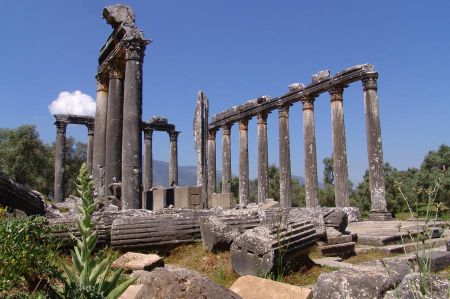Euromos, the delightful city of Antique Caria
- Written by Portal Editor
Euromos, one of the antique cities of Carian lands, located between Lake Bafa and Milas town, is about 12 km away from the town center of Milas.
Still standing in their grandeur, columns of this enigmatic temple of the city salutes you from amongst the olive groves as you travel along the main road.
Builder and commissioner Emperor Hadrian
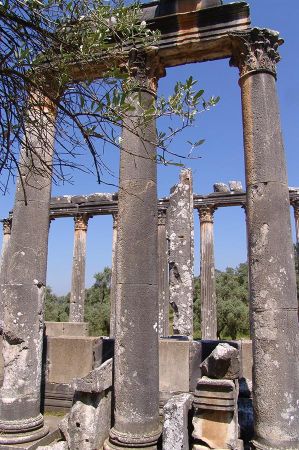 Euromos is indeed one of the rare antique settlements that you could easily reach to by simply following the road signs, Euromos is first mentioned in 500 BC under the name of Hyromos / Kyromos. It is thought that the name of the city has evolved to Euromos in time in the Hellenic dialect. The list of cities paying tax to Attica-Delos League formed under the guardianship of Athens against the Persians contains the name of Euromos as a member.
Euromos is indeed one of the rare antique settlements that you could easily reach to by simply following the road signs, Euromos is first mentioned in 500 BC under the name of Hyromos / Kyromos. It is thought that the name of the city has evolved to Euromos in time in the Hellenic dialect. The list of cities paying tax to Attica-Delos League formed under the guardianship of Athens against the Persians contains the name of Euromos as a member.
Euromos city was invaded by Macedonian King Philippos V. between 221 and 179 BC and again invaded by its southern neighbour Mylasa in 167 BC. Subsequently, freed from the invasion of Mylasa with help from Rhodes, the city had to form an alliance with Mylasa at a later stage. Not happy with the alliance, its neighbour Heraclea attacked Euromos and seized many important assets of the city.
Euromos antique city is regularly mentioned in sources regarding the Carian and it is accepted that she was the most important Carian city second to Mylasa.
The city gained fame with its coinage carrying a depiction of Zeus. Coinage belonging to the city of Euromos has been found at the Caunos archaeological excavations. It has been established that Euromos in fact continued to mint its own coinage in the Roman era as well.
Building materials misused for other buildings
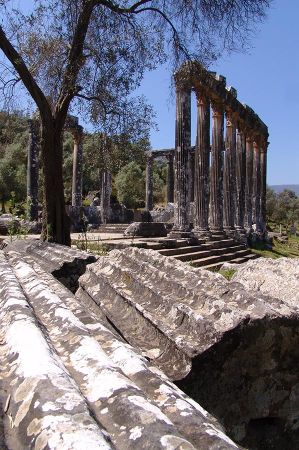 The most important structure that has survived from this delightful city is the Temple of Zeus, which is formidable and has much more estetic appeal than its contemporaries. Constructed at a foothill and dedicated to god Zeus, it is suggested that the temple was erected in the Roman era in 200. A.D. One of the best preserved temple structures in Anatolia, 16 of the Corinthian style columns are still standing. For that reason, the antique settlement is known as “Pedate “amongst the locals. The inscriptions on columns contain a list of those who have contributed financially help to the construction if the temple.
The most important structure that has survived from this delightful city is the Temple of Zeus, which is formidable and has much more estetic appeal than its contemporaries. Constructed at a foothill and dedicated to god Zeus, it is suggested that the temple was erected in the Roman era in 200. A.D. One of the best preserved temple structures in Anatolia, 16 of the Corinthian style columns are still standing. For that reason, the antique settlement is known as “Pedate “amongst the locals. The inscriptions on columns contain a list of those who have contributed financially help to the construction if the temple.
Archaeological excavation and restoration works around the Zeus temple began in 1970’ies but were abandoned at a later stage and no more work has been done since then. If you go for a walk around the hillsides on western side of the temple, you will discover the city walls.
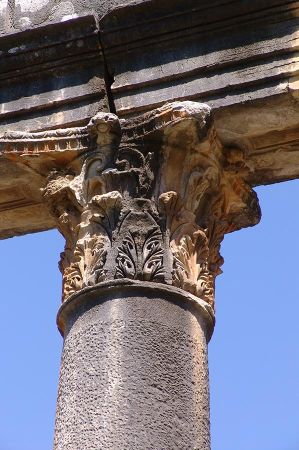 The city’s theatre is nestled into the niche that is carved into the hillside just over the north east lowland. Considerably dilapidated, this structure now stands amongst olive groves and only 5 rows of seating are visible. Scattered on a wide area on both sides of the land route, the remnants of this antique city seems to be longing for the days when they come to light and present the discovering visitors with a visual feast.
The city’s theatre is nestled into the niche that is carved into the hillside just over the north east lowland. Considerably dilapidated, this structure now stands amongst olive groves and only 5 rows of seating are visible. Scattered on a wide area on both sides of the land route, the remnants of this antique city seems to be longing for the days when they come to light and present the discovering visitors with a visual feast.
Set amidst the rolling hills and olive groves of Turkey's Muğla region lies Euromos, one of the best-preserved ancient cities of Caria. Known for the impressive Temple of Zeus Lepsynos, Euromos offers a fascinating insight into the ancient world. But this site is more than just a temple - it tells stories of glory, trade and religious devotion.
The History of Euromos
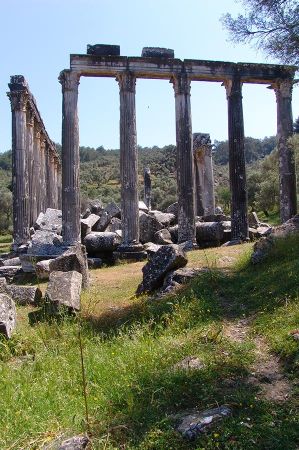 The Origins of Euromos
The Origins of Euromos
The roots of Euromos date back to the 6th century BC. The city was a significant part of the Carian civilisation and was influenced by various cultures over the centuries.
The Golden Age During the Hellenistic and Roman Eras
The Hellenistic period saw Euromos flourish culturally and economically. Under Roman rule, the city was further expanded, with the Temple of Zeus Lepsynos being built.
The Decline and Rediscovery
After Late Antiquity, Euromos lost importance and fell into oblivion. It was only in the 20th century that archaeologists began to systematically explore the site and recognize its historical value.
The Temple of Zeus Lepsynos - A Masterpiece of Architecture
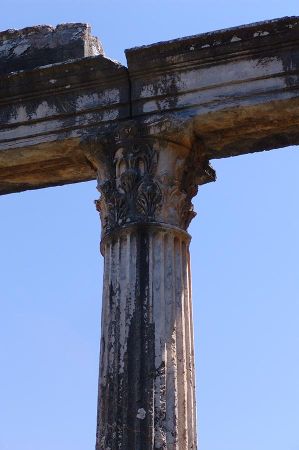 History of the Temple
History of the Temple
The Temple of Zeus Lepsynos was built in the 2nd century AD and is considered one of the best preserved examples of Roman temple architecture in the region.
Architecture and Design
The temple is characterized by its Doric columns and the harmonious arrangement of the columns. Of the original 17 columns, 16 are still standing today, which makes the temple particularly impressive.
The state of preservation and current restoration work
Thanks to careful restoration work, the temple remains a highlight for visitors and a valuable object for archaeology.
Other sights in Euromos
The ancient agora
The agora was the economic and social center of Euromos. Traders and citizens met here to exchange goods and hold political discussions.
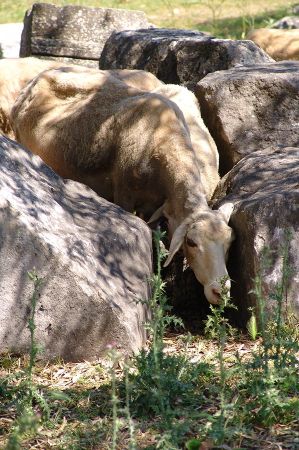 Theater and other public buildings
Theater and other public buildings
The theater of Euromos provided space for cultural events and political meetings. It is a testament to the vibrant community that once lived here.
Necropolis and Tombs
The Euromos Necropolis bears witness to the burial rituals of the ancient world and offers insight into the religious beliefs of the time.
The Importance of Euromos in Antiquity
Political and Cultural Role in Caria
Euromos was an important player in the political and cultural landscape of Caria, playing a key role in regional alliances.
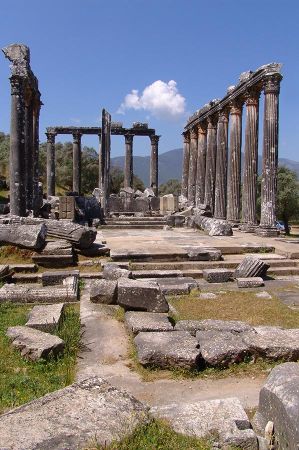 Trade Relations and Economic Importance
Trade Relations and Economic Importance
Thanks to its strategic location, trade flourished in Euromos, bringing wealth and influence to the town.
Religious Practices and the Cult of Zeus Lepsynos
The cult of Zeus was central to religious life in Euromos, and the temple was an important pilgrimage site.
Euromos Today – A Hidden Gem for Travelers
Location and Getting There
Euromos is close to Milas and is easily accessible by car or public transport.
Tips for Visiting
Visitors should wear comfortable shoes and allow plenty of time to explore the site at their leisure.
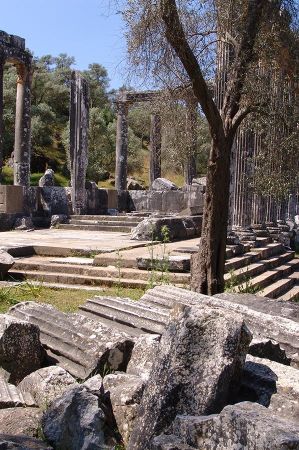 Significance for archaeology and tourism
Significance for archaeology and tourism
Euromos is not only a highlight for history buffs, but also an important site for archaeological research.
Conclusion
Euromos is a fascinating combination of history, architecture and nature.
Whether you are a history buff or a casual traveler, this ancient site offers an unforgettable experience.
Please read as well:
History of Perge - long lasting story of a city
Sirmium - today Sremska Mitrovica in Serbia
-
 Euromos - Ancient town built by Hadrian
Euromos - Ancient town built by Hadrian
Euromos - Ancient town built by Hadrian
Euromos - Ancient town built by Hadrian
-
 Euromos - Ancient town built by Hadrian
Euromos - Ancient town built by Hadrian
Euromos - Ancient town built by Hadrian
Euromos - Ancient town built by Hadrian
-
 Euromos - Ancient town built by Hadrian
Euromos - Ancient town built by Hadrian
Euromos - Ancient town built by Hadrian
Euromos - Ancient town built by Hadrian
-
 Euromos - Ancient town built by Hadrian
Euromos - Ancient town built by Hadrian
Euromos - Ancient town built by Hadrian
Euromos - Ancient town built by Hadrian
-
 Euromos - Ancient town built by Hadrian
Euromos - Ancient town built by Hadrian
Euromos - Ancient town built by Hadrian
Euromos - Ancient town built by Hadrian
-
 Euromos - Ancient town built by Hadrian
Euromos - Ancient town built by Hadrian
Euromos - Ancient town built by Hadrian
Euromos - Ancient town built by Hadrian
-
 Euromos - Ancient town built by Hadrian
Euromos - Ancient town built by Hadrian
Euromos - Ancient town built by Hadrian
Euromos - Ancient town built by Hadrian
-
 Euromos - Ancient town built by Hadrian
Euromos - Ancient town built by Hadrian
Euromos - Ancient town built by Hadrian
Euromos - Ancient town built by Hadrian
-
 Euromos - Ancient town built by Hadrian
Euromos - Ancient town built by Hadrian
Euromos - Ancient town built by Hadrian
Euromos - Ancient town built by Hadrian
-
 Euromos - Ancient town built by Hadrian
Euromos - Ancient town built by Hadrian
Euromos - Ancient town built by Hadrian
Euromos - Ancient town built by Hadrian
-
 Euromos - Ancient town built by Hadrian
Euromos - Ancient town built by Hadrian
Euromos - Ancient town built by Hadrian
Euromos - Ancient town built by Hadrian
-
 Euromos - Ancient town built by Hadrian
Euromos - Ancient town built by Hadrian
Euromos - Ancient town built by Hadrian
Euromos - Ancient town built by Hadrian
-
 Euromos - Ancient town built by Hadrian
Euromos - Ancient town built by Hadrian
Euromos - Ancient town built by Hadrian
Euromos - Ancient town built by Hadrian
-
 Euromos - Ancient town built by Hadrian
Euromos - Ancient town built by Hadrian
Euromos - Ancient town built by Hadrian
Euromos - Ancient town built by Hadrian
-
 Euromos - Ancient town built by Hadrian
Euromos - Ancient town built by Hadrian
Euromos - Ancient town built by Hadrian
Euromos - Ancient town built by Hadrian
https://www.alaturka.info/en/turkey-country/aegean/aydin/2207-euromos-the-delightful-city-of-antique-caria#sigProIded103447e6
